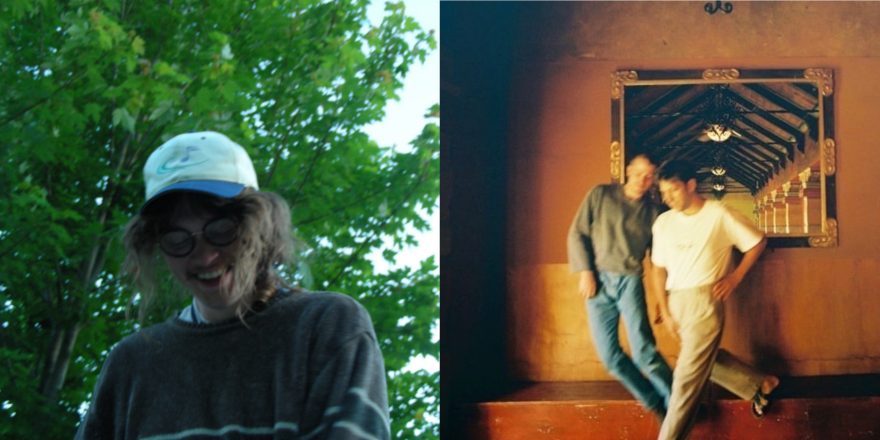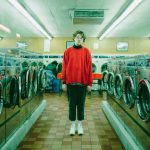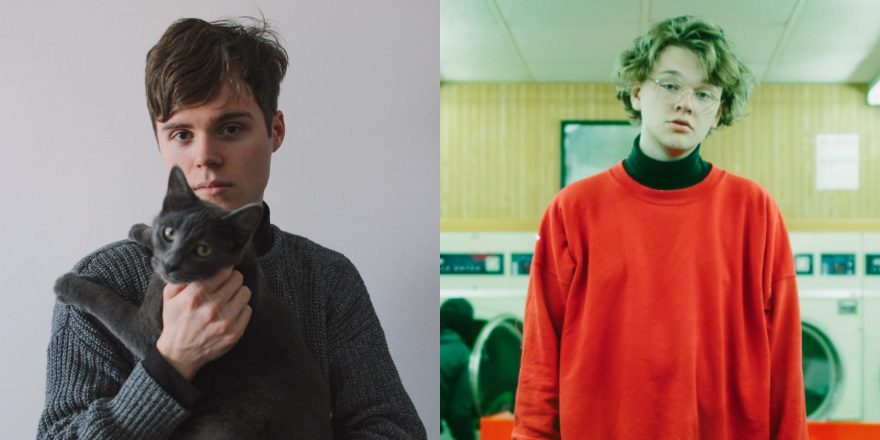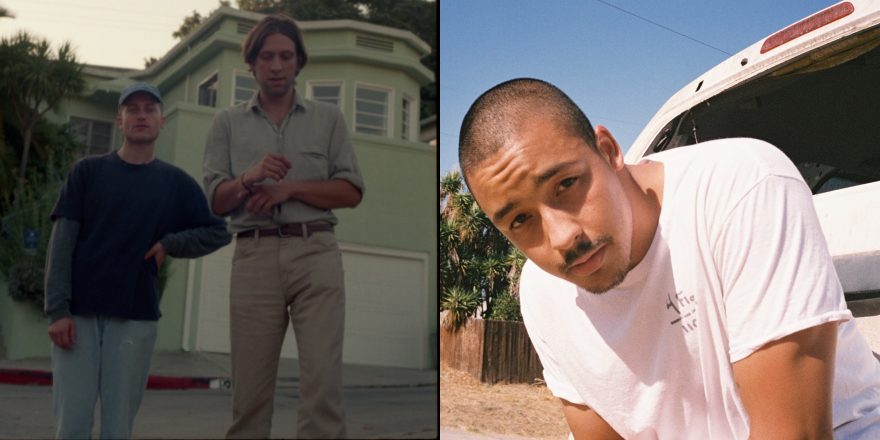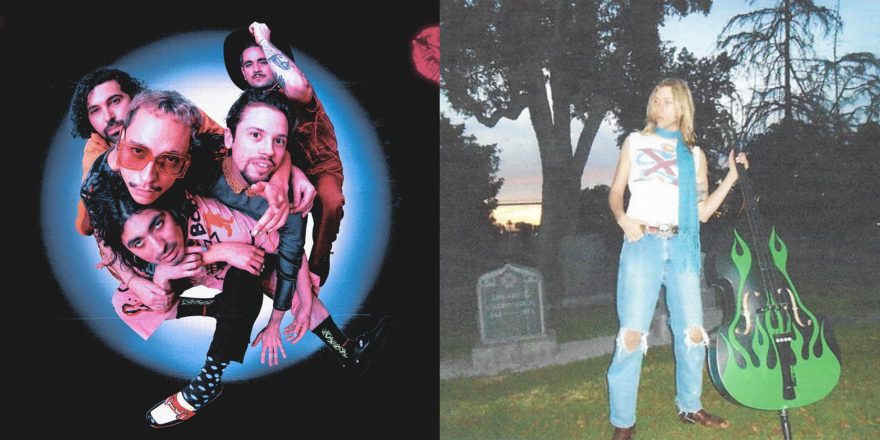Hovvdy is the Texan indie pop duo of Charlie Martin and Will Taylor; Ghost Orchard is the recording project of the Michigan-based artist Sam Hall. The latest Ghost Orchard record, Rainbow Music, was just released on Winspear this past November, so to celebrate, the three friends hopped on a Zoom call before the holidays to catch up about it, and much more.
— Annie Fell, Editor-in-chief, Talkhouse Music
Sam Hall: What’s up, guys? How are you doing?
Charlie Martin: What’s up, Sam?
Sam: I’m just simply chilling today. I was catching up on the phone with a friend of mine earlier, but now I might do some laundry. It’s a slow day. How is it for you guys? You guys are recording right now, right?
Charlie: Yeah, it’s creeping. I live in Saint Louis now and Will’s still in Texas, so we all linked up in Asheville, North Carolina, where Ben [Littlejohn] is living these days. [Andrew] Sarlo flew out from LA. So yeah, we started a new record.
Sam: The wombo combo dream team.
Will Taylor: It’s exciting, yeah. The through line with our projects right now — I feel like it’s very strong, and I love what [Ben] brought to your project too. [Ben contributed to the new Ghost Orchard record.]
Sam: I want to bring him back! He’s too good. [Laughs.]
Will: It’s crazy how quickly he can just throw you a million dubs and it makes all sense. Like, it’s all good.
Sam: Yeah. I think I hit him up about the project because I was really stuck with where all the songs were at. Like, they were there, but I wanted to push them further. I don’t think anybody else has played on my songs before, besides me, so I was like, OK, what is this like? I sent him a message literally a day and a half later, I had, like, 40 stems, just off the dome. It’s crazy. They’re perfect. It made it what it is.
Will: It’s interesting how a contribution can inspire you or make you rethink even how the chords go. Like sometimes I send Ben a song with kind of ambiguous chords, and his interpretation of the chords is way better than anything I could have come up with.
Sam: 100%. It made me appreciate the importance of a second perspective or somebody else getting their hands on it. I’m interested to pursue that further with even mixing or mastering, just to see what someone else does with it. Because there’s a couple of things that I kick myself on later on, like, Oh, I might have mixed the highs too much on this song, and I didn’t even realize it until a year later, because it just sounds normal at the time.
Will: Mixing regret is real for sure. To dump that on somebody else is very therapeutic. [Laughs.]
Charlie: Yeah, it’s amazing. Me and Will constantly talk about how bad our first two records sound, the ones that we mixed ourselves. People say kinds of things about them, but…
Sam: I’ve mentioned to you guys before how much I love how those first two records sound. I remember when I booked you guys at Witch House in Grand Rapids, like, forever ago, I asked you if you went to a studio.
Charlie: Yes, a notorious show for us.
Sam: Yeah, I miss that place. It still gets talked about — everybody that’s played there was like, “Oh, yeah, that was a good one.”
Will: That was a great show. It was funny, that was in the middle of a tour, and we all got discombobulated and played a different song one time, and so we always talk about each four of us played a different song for, like, 30 seconds one time.
Sam: [Laughs.]
Charlie: Yeah, that’s the one time in our whole careers where the band collectively got too stoned and then played bad. Like, we didn’t do well. [Laughs.]
Will: Sam, I was just listening to the album in preparation for this, and I felt really compelled by the vocals. It just feels like they’re vocals that you can’t really replicate, which is interesting — like, maybe not even you could, which is fun. The way I approach stuff is just trying to make it sound the exact same 10 times, and stacking them or whatever. Who knows your process — you may do stacks, but it sounds like you couldn’t even if you tried. And I feel like that’s something about your music that’s pulled me from the start, you know, creating something really unique with your voice and using it as instrument and as an emotive tool. On Rainbow Music, that stuck out to me more so than even in the past.
Sam: Yeah, it’s a blessing and a curse, you know, because I’ve been talking to the Winspear guys a lot the past couple of days about how I’d really like to do shows. But with this record specifically, I’m like, How do I even go about approaching that? Because like the last time I played shows was with you guys, and I just did a backing track. Those shows went good, but I look back at what I was doing before with a band and everything, and it just feels a whole lot more rewarding, I guess. But you look at a song like “Jessamine” and it’s like, how do I do that? Because I formant pitch my vocals, and then I pitch the whole song up, so it’s like it’s a different voice entirely. And I’m just I’m a little stuck right now with how I do that in a live setting. How do I play three breakbeats at once live?
Charlie: [Laughs.]
Will: Yeah. I mean, it does feel like there’s always this core of a song, like you could sit with an acoustic guitar and play the tune. I’m curious: when you’re writing, is it mostly production based in terms of the process? Or do you write a tune on the guitar and then bring it to the production stage?
Sam: It goes back and forth. I think the songs that I’m the happiest with are songs that I did like on the fly, just kind of sitting in Ableton with nothing written beforehand. I think half the songs on the record are like that. But then “Dancing” and “Soot” I wrote before I recorded them. I kind of prefer to write while I’m recording, just because every time I write a song outside of a recording environment, I kind of have an expectation, I guess, of what I want the recording to sound like, and I can never get it there. I don’t know why that is. But the ones that are just off the cuff, just feel good.
Charlie: Yeah, that makes sense. It makes the production feel even more essential to to the song.
Sam: Yeah. Because when I’m doing it in Ableton, I’m kind of just having fun. And I might not even realize that I’ve stacked, like, four different drum parts on top of each other. It’s something I’ve realized because we’re putting some remixes together, and the ones that I’ve heard are pretty minimalist. It’s cool to hear the stems taken away. It’s made me want to, approach music a little less sonically maximalist, because I feel like [with] this whole record, you can dig through the songs forever and find different stuff, and that’s really cool. I definitely appreciate it as just a music enjoyer, I guess. But there’s something to be said about the inverse too — just like every piece is essential. I’d like to give that a bit more of a try for sure.
Will: I’m curious, how was “Maisy” made? Was that a thought-[out]-before, or was that from scratch in the computer?
Sam: I wrote the guitar part by itself — I was just playing the riff. But there’s a sweet spot when you write a song of not playing it too much before you record it, and just getting kind of the raw initial feeling. So with that one, I was able to like, be like, OK, this is good. Let’s record it right now. So I think I recorded it the same day. I didn’t write the vocal part until as I was doing it.
That one and “Cut,” I wrote and recorded the same day. They were the some of the last songs for the record. I think the last song [on the record] was the last thing I recorded, but those two happened right when I first started talking to Nik [Arthur] about visual stuff, and it was like the last little push I needed to be like, Oh yeah, I gotta finish this record. So I just did those two. I think “Cut” is probably my favorite still, just the end of that song.
Will: Yeah, how it goes into “Soot” is ridiculous. For a while, I didn’t know, or really care, when “Cut” ended and “Soot” began. I realize it’s a quick start, but the end of “Cut” sounds like the beginning. And the reason I asked about “Maisy” is because it felt kind of wide open — like you maybe had a moment where… To use an example, for some of Charlie’s songs there’s a moment where there’s like a sing-out, and then there’s a release. I felt it with “True Love,” in his demo of that song — that kind of shout out, open wide, kind of joyful mood. So it’s interesting, the different approaches that can lead you to that similar feeling.
Sam: Yeah, it was definitely a moment where I was like, OK, I have all these songs that are kind of firing on all cylinders the whole time, So I wanted to pull things back a little bit and also kind of lighten the mood. Because, I mean, the record as a whole… Rainbow Music is music from all the different feelings from me. [“Maisy”] is the fourth song on the record, and the first three are a lot emotionally, I guess, so I just wanted to put something in there where I was like, “OK, yeah, there’s good stuff, too. It’s not all sad.” [Laughs.]
Charlie: Oh, yeah. I feel like you do a wonderful job at toeing that line. Definitely lots of push and pull. And your vocal tone alone kind of carries this very unique weight to it. This record especially is that rare project where you could show it to some hyper-intelligent music kid and they can really sink their teeth into it, or you can just pop it on in a social environment and it’s exactly what everyone wants without really knowing it. In the van, we would just listen to it all the time. You should just be really proud. It’s one of my favorites, if not my favorite project, of the year.
Sam: Man, thank you so much. I really appreciate it.
Charlie: We’ve come a long way, you know? It’s wild.
Sam: Yeah. I feel like you guys are tapped into similar music that I am, and it’s been cool because I feel like we both kind of recognize that within whatever we’re doing, and try to keep it moving forward. I want the records to not do the same thing every time, and with this record, part of that idea was making experimental music digestible to people, and be like, “Oh, what is more music that sounds like this five second part of this song?” And just get other people dig into it.
Charlie: Yeah, I’m with you. I love to make music that’s… I don’t know, I’m not trying to challenge people too much, to be honest. Like, I want people to just enjoy it kind of on a base level. And then if they have the time and the energy to dig in in a deeper way, that’s great. That’s ideal. But it’s nice to kind of have that humbleness at the core of a project, where you’re just happy for people to just enjoy it.
Sam: 100%. Keeping that sort of through line of a pop sensibility in an otherwise pretty experimental song — you guys do it, Dijon does it a lot. It’s cool. It’s the most exciting thing I can think of with modern music, the genre blending of everything. The last Alex G record is like that a lot too, where it’s just putting everything out there and if you know, you know, and if you don’t, you’re going to learn something. It’s the most rewarding listening experience, I feel like.
Will: I think what’s really cool about all those artists, and something that I’ve learned from them and been like freed up to try more, is to just make the live set its own thing. The way that we perform is more like a rock band live, and I feel like that does take some people by surprise. And it might not ultimately be the best thing for us, but we just kind of end up doing it — more feedback and louder rock drums and stuff. But yeah, I would be curious to see what a Ghost Orchard set would be like that didn’t remember what the album sounded like.
Sam: That’s how we used to do it. Did I play with you guys when you played at Witch House? I can’t remember.
Charlie: Yeah, I think you did. And it was, like, super rockin’.
Sam: Yep. We used to just have it the same way, where it was its own thing. My apprehension with a live set for the longest time has been… I always think of the Beatles, because the Beatles just stopped playing shows to make more music instead, and I always thought that was the right move. But you kind of get a little bit of both when you remake the songs for a live band. So if I did it, it would probably be more adjacent to that, because it was a lot of fun. And it’s cool to have it be its own thing.
Charlie: It is. I guess the best example of this is when we’re opening for other bigger artists, and you kind of feel like you gotta entertain and win them over.
Sam: Sure.
Charlie: Those are always fun challenges for us. And I think that that’s if we’ve gotten better live is because of those experiences. But it’s funny, because when you’re in the lab and working on recordings, you have the bigger picture in mind and you don’t have to jump up and down and sing as loud as you can to get the point across.
Will: Yeah. I’ve always struggled with framing how I’m going to record the song with the live performance in mind. Like the vocals I record at 2 am, when I’ve been up and I’m very tired — my range is very different in that moment than it is when I’m shouting into a microphone on stage. So it’s been frustrating at times to translate them. And even if you make an overly intricate recording like I’ve done, and it’s just too difficult to make it hit live, that’s also frustrating. So it is a weird balance.
Charlie: Yeah. It’s really just breakbeats, I feel like. Breakbeats are so hard, because you have to be such a good drummer to pull that off. So it’s either that or you have tracks, which is fun, but it’s a push and pull for sure.
Sam: Yeah. I’ve considered trying to do a blend of the both of them, like doing in-ears with some backing track. Because to go back to “Jessamine” again — what do I do with the vocal chops at the end of the song? What is a feasible way to replicate any sort of feeling like that? And that’s the only place I can come to, even if I make it into a different song without breakbeats. Which would be cool and I’d definitely be down to try out.
Charlie: Yeah. It is possible to make a really simplified breakbeat just into the backbeat — like a song like “Mr. Lee” has a breakbeat at the core of it, but when we play it live, we kind of just turn it into a country song and it really works.
Sam: That’s beast. I love that. [Laughs.]
Will: There’s some songs on the record that are full instrumental, and then there are some that just have a section — or, I don’t even know if it’s just a section if it really counts as instrumental. But I’m curious how you find the places to put them. If it’s intentional or if it falls in, or do you want to give people a break from a voice? Because I can relate to that.
Sam: I think with this record specifically, I was listening to Fantasma a lot, by Cornelius. It is kind of just like an all out sonic assault with, like, 50 different genres every other song. It was just so appealing to me. I love when records feel like it’s a contained universe. So I guess the constant shape shifting of the songs comes from that, just to give that feeling of like, this is like a living, breathing thing. And there’s like a certain allure within the mystery of… I don’t know, like the end of “Soot” has that little keyboard thing, and that was from two years before I wrote that song. It’s like Easter eggs, kind of.
Will: Or collages.
Sam: Yeah, just to kind of blend all the different feelings together, I guess.
Will: And the feelings that span time, that’s what’s cool too. That’s what’s fascinating about the freedom of approaching music that way, that you pull fragments from different times and put them in the same frame and it feels different, but the same. It’s interesting.
Sam: Yeah, because with this record, initially making these songs was a way for me to process a lot of grief, the things that were going on in my life at the time. And I thought that I was making a record about kind of growing through grief and all of that, but it honestly, more than anything else, feels almost like a coming of age record. Like self-referencing and looking back in time and putting it all together to make this amalgamation of like who I am at 23, 24. So I was pleasantly surprised with the outcome.
Will: Does the title have anything to do with the metaphor of like, light-at-the-end-of-the-tunnel energy, or is it simply a comment on the variety of the sonic landscape?
Sam: Yeah, it’s both. There used to be a music gear shop in Grand Rapids called Rainbow Music, and I always loved the name. And when all the songs were coming together, I wanted to do something with rainbows, just because I was pretty infatuated with them at the time, just because of that idea that there’s a rainbow after the storm. But then I was like, Oh, I’m just going to steal the Rainbow Music name from them because they closed. [Laughs.] Because it applied in so many different ways, like the sonic rainbow, emotional rainbow, rainbow after all the pain. It just fit.


